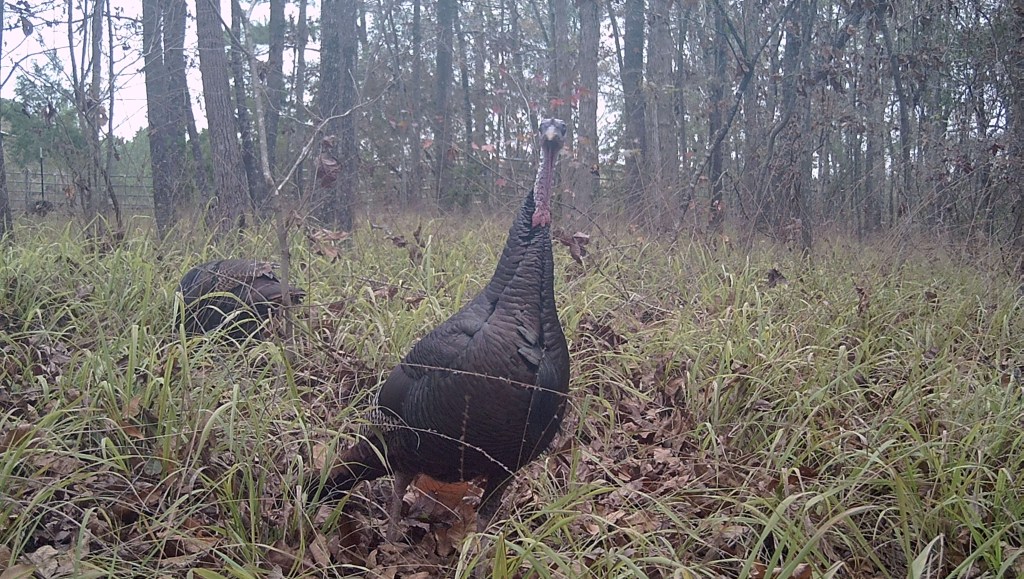Deer season gives way to small game, habitat work for turkeys
Published 5:32 pm Monday, February 5, 2024

- A pair of gobblers walk on top of a ridge in an open area. Burning areas where there is sunlight reaching the forest floor can promote a positive plant response and enable the structure need for brood or nesting habitat to grow. (The Brookhaven Daily Leader)
By Hunter Cloud
The Natchez Democrat
Wednesday was the final day of deer season in southwest Mississippi which frees up time for other outdoor activities. Small game hunting such as squirrels and rabbits are open until Feb. 28 and habitat work for turkeys and deer can occupy hunters until the spring turkey season and next deer season.
Habitat management is needed to improve wildlife populations and hunting quality in future seasons. A tip for prioritizing habitat work and hunting in February is simple. Windy, rain soaking and frigid weather conditions are not always conducive to good squirrel hunting which makes them great candidates for habitat work days.
Trending
Small game hunts on good weather days allow hunters and managers to observe the property and what work is needed over the next year. MDWFP Turkey Program Coordinator Adam Butler said normal levels of small game hunting pressure in February should not have a negative impact on turkeys.
“I’ve never seen any kind of research that normal squirrel hunting pressure will cause problems for turkeys over a long period,” Butler said.
Steps to manage
Before you even start working it is best to have a plan for your property. Write down a list of goals and what you want to accomplish with your work. Mississippi Department of Wildlife, Fisheries and Parks offers a free private lands visit to help hunters in making a management plan.
Next, draw a map of your property or use a map on your phone and break up the property into different sections. One method to break up the property is based on shared habitat qualities. Old fields, streamside management zones, upland pine and hardwood mix stands and hardwood bottoms are the most common habitat type found in Lincoln County. Managers can also break the property up into quadrants.
It is recommended to take on the lowest hanging fruit first in terms of plant succession. Clearings and openings should be first priority because of the cover they provide to turkeys and fawns in early life history. Herbicide applications, mechanical disturbances such as disking and burning can help set back the plant succession and maintain herbaceous plant cover. At a minimum, 10 percent of a heavily forested property should have maintained openings.
Trending
Due to the intense summer heat, it is not a bad idea to take care of work in open fields first during the cold weather months. Managers should save work for shaded forest areas for the hottest part of the year especially in creek bottoms where it is a little cooler.
It is also important to maintain an infrastructure to access areas of your property and make movement for wildlife easier.
Management requires commitment because the fruits of labor may not be reaped in the first year of work. Habitat management is an ongoing process as the natural world also changes.
Tools you need
All of this work is easier if you have a chainsaw, a tractor with a disk attachment and a backpack sprayer. However, it can be done with hand tools and sweat equity. Depending on the property it may be easier to get hand tools into areas which do not give good access to equipment.
A chopping axe can help you cut down trees, shrubs and privet hedges. Machetes and kaiser blades can allow you to clear paths or thin out areas where one plant has created a monoculture, such as goldenrod.
Bow rakes can help you remove the thatch left on the ground and create fire breaks for prescribed burning. A garden hoe can help disk up areas and stimulate the natural seed bank although it may be easier to use a shovel depending on your soil type.
Fire is a great tool when used appropriately and legally. Prescribed burns in February can help enhance habitat for turkeys. Work done in February can bear fruit in time for turkeys to nest and hatch broods this spring.
“This is the month to burn if you can if you have any kind of upland habitat. Now is the perfect time to do that,” Butler said. “It isn’t the only time to burn but if you burn now the green up will come along and pays dividends. It will also overnight make areas extremely attractive to turkeys. Those places will be highly selected for in March and April. When we get into summer, the green up will be prime time brood habitat.”
February should be a busy habitat work month for turkey hunters ahead of the hunting season and the hatch of turkeys which follow. People may focus on trapping nest predators in February but predator control only works well when paired with quality habitat for nesting and brood rearing.
Butler said February is the time to get work done. Open fields and old field habitat can also benefit from prescribed burning. On the flip side, February is not the best month to treat openings with herbicide. Late spring and early summer is the best time to use herbicides in management work.
Reading and listening are great tools in your management tool box. Mississippi State University Extension Service and Mississippi Department of Wildlife, Fisheries and Parks provide a variety of publications for habitat management and understanding the biology and ecology of wildlife species. Podcasts such as Wild Turkey Science, Fire University, Habitat University and Deer University are great resources for habitat work.





